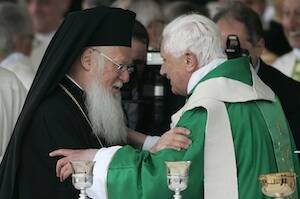Developed by the North American Orthodox-Catholic Theological Consultation during a three-day meeting at Georgetown University in Washington, two “unprecedented” statements released on Oct. 7 offer a vision of what the unity of the two churches might look like. Steps Toward a Reunited Church offers a vision of the possible shape of a reunited church resulting from the re-establishment of full communion. The second statement, Celebrating Easter/Pascha Together, focuses on the importance of a unified celebration of Christ’s resurrection. The statements identify areas where the churches diverge in leadership and other practices, such as the role of the pope, that must be reconciled before the nearly 1,000-year separation between the churches can end. Ronald Roberson, a Paulist priest who is the associate director of the U.S. Conference of Catholic Bishops’ Secretariat for Ecumenical and Interreligious Affairs, said the divided churches now “dimly perceive” what a united church would look like. “Obviously for that to happen,” he said, “Catholics would have to adjust and Orthodox would have to adjust.”
A Vision of Unity
Show Comments (
)
Comments are automatically closed two weeks after an article's initial publication. See our comments policy for more.
The latest from america
After an early morning attack on the Holy Family Church in Gaza, Pope Leo XIV called for an immediate ceasefire, dialogue and peace in the region.
Something essential is lost when generations remain siloed at church.
You’ve got a 401K. But do you have a spiritual retirement plan?
A brief opening to shore up progress toward stability in Syria unfortunately coincides with Trump administration decisions to sharply curtail humanitarian and development assistance and to terminate the U.S. Agency for International Development.








